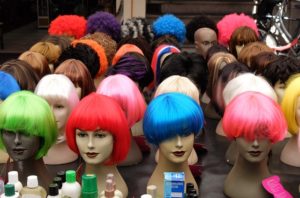We all use hair colors for different reasons. No matter the reason, chemical hair dyes do damage hair and often leave hair dry, dull and lifeless.
Many have caused damaged hair that’s often beyond repair with constant styling, coloring and using other chemical or heat treatments for their hair. However, with increasing awareness on the effect chemicals and other treatments have on hair, many are looking at natural coloring options for hair.
It is important to understand that there are both temporary and permanent options for hair color but a little understand on the ingredients is important. Many are misguided on how to use what and end up getting frustrated with the results.
So, we’re going to talk about the different options we have for coloring hair without using those chemical hair dyes or colors.
The different between the temporary and permanent dye lies in the size of the molecules. Permanent coloring aids have smaller molecules that penetrate the shaft and hence the color stays. Temporary ones have a larger molecule size, so they leave a layer of coloring that fades away with time and washing.
There are different options when coloring hair naturally – Henna, Katam, Indigo Leaves, Khatha, etc. All of these ingredients are permanent coloring options for hair.
On the other hand, food-coloring options like Coffee, Tea, Beets, Berries, certain herbs and flowers or even roots, will fall under the temporary coloring option.
Henna is the most common coloring aid and the fiery copper or orange shade can be subdued and tweaked to suit your hair color preference with other ingredients like Indigo Leaves, Khatha, Indian Gooseberry, False Daisy or even Coffee or Tea are used to make the color darker to get shades of Brown – Black.
Along with Henna, even Beetroot, Berries, Hibiscus or other ingredients are added depending on the end result expected. These highlight the reddish tones, though it fades with time or wash.
Katam is a popular coloring option but quite rare and with the only source being Yemen pricey, hard o get and often unavailable – due to the political issues in the region. This means, it is difficult to ascertain the quality of Katam you get.
Khatha is used to get a brown coloring and often used with or without Henna. Though like Henna other ingredients are added to get the desired color including Indigo Leaves. However, it is more often combined with Henna and used to get different hues of brown.
Indigo Leaves is combined with Henna to get a darker shade of brown or to color black. However, while this does color hair permanently like Henna, doesn’t work alone! This sort of gives a blue color as the name indicates – Indigo and needs the orange from Henna to color hair brown or black. However, when applied alone, does nothing for hair, especially for covering grays or for lighter hair colors.
Coffee and Tea color the hair, but depending on the method used for coloring, fades away. They are used in combination with Henna to achieve a darker color, but alone, they don’t last longer.
Want to know more about other coloring options including herbs, flowers, roots and teas? Stay tuned – we will discuss more on this in detail. We will also cover all the options and how to get funky colors without using those harsh dyes! Until then, try out the DIY Recipes listed here for coloring your hair or for caring for your hair and scalp. If you don’t have time for DIY, try HY Vitamins for your hair and scalp care.

